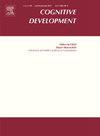The prediction of syllable awareness, character reading ability, and rapid automatized naming on phoneme awareness: Evidence from a longitudinal Cross-lagged model
IF 1.8
3区 心理学
Q3 PSYCHOLOGY, DEVELOPMENTAL
引用次数: 0
Abstract
Background
Phonological awareness is a crucial factor for the development of reading ability. Yet, a comprehensive understanding of the impact factors of phonological awareness in early age is still a challenge.
Method
A total of 127 young Chinese children were tracked two times. The dynamic phoneme deletion task, syllable deletion task, character recognition task, and rapid automatized object naming task were used to measure phoneme awareness (PA), syllable awareness (SA), character reading (CR), and rapid automatized naming (RAN), respectively. Cross-lagged panel model was used to examine the longitudinal and bidirectional relationship among these four reading skills.
Results
Children’s performance improved on all four tasks across the two points. Both of CR and RAN had low to moderate correlations with phonological awareness at both time points. Cross-lagged panel model results showed that: 1) SA, CR, and RAN at T1 significantly predicted PA at T2, but PA at T1 did not predict other reading-related skills at T2; 2) CR at T1 positively predicted SA at T2.
Conclusions
SA, CR and RAN at earlier time are important predicting factors of the development of PA. Larger phonological awareness units (syllable) not only precede but also impact the development of smaller units (phoneme). CR can enhance phonological awareness at both larger (syllable) and smaller (phoneme) units.
音节意识、字符阅读能力和快速自动命名对音素意识的预测:来自纵向交叉滞后模型的证据
语音意识是阅读能力发展的关键因素。然而,全面了解幼儿语音意识的影响因素仍然是一个挑战。方法对127名中国儿童进行了两次跟踪调查。采用动态音素删除任务、音节删除任务、字符识别任务和快速自动对象命名任务分别测量受试者的音素意识(PA)、音节意识(SA)、字符阅读(CR)和快速自动命名(RAN)。采用交叉滞后面板模型对四种阅读技能之间的纵向和双向关系进行检验。结果两组儿童在四项任务上的表现均有提高。在两个时间点上,CR和RAN与语音意识都有低到中等程度的相关性。交叉滞后面板模型结果显示:1)T1时的SA、CR和RAN显著预测T2时的PA,而T1时的PA不能预测T2时的其他阅读相关技能;2) T1时CR正预测T2时SA。结论早期sa、CR和RAN是预测PA发生的重要因素。较大的语音意识单元(音节)不仅先于而且影响较小的单元(音素)的发展。CR可以增强较大(音节)和较小(音素)单位的语音意识。
本文章由计算机程序翻译,如有差异,请以英文原文为准。
求助全文
约1分钟内获得全文
求助全文
来源期刊

Cognitive Development
Multiple-
CiteScore
3.20
自引率
5.60%
发文量
114
期刊介绍:
Cognitive Development contains the very best empirical and theoretical work on the development of perception, memory, language, concepts, thinking, problem solving, metacognition, and social cognition. Criteria for acceptance of articles will be: significance of the work to issues of current interest, substance of the argument, and clarity of expression. For purposes of publication in Cognitive Development, moral and social development will be considered part of cognitive development when they are related to the development of knowledge or thought processes.
 求助内容:
求助内容: 应助结果提醒方式:
应助结果提醒方式:


